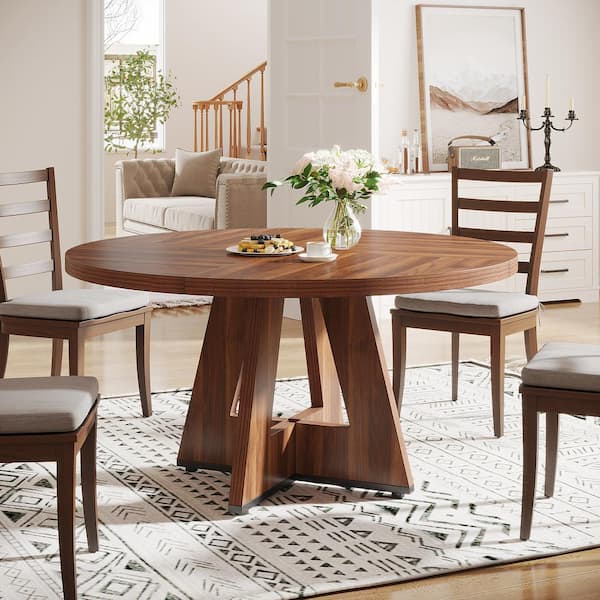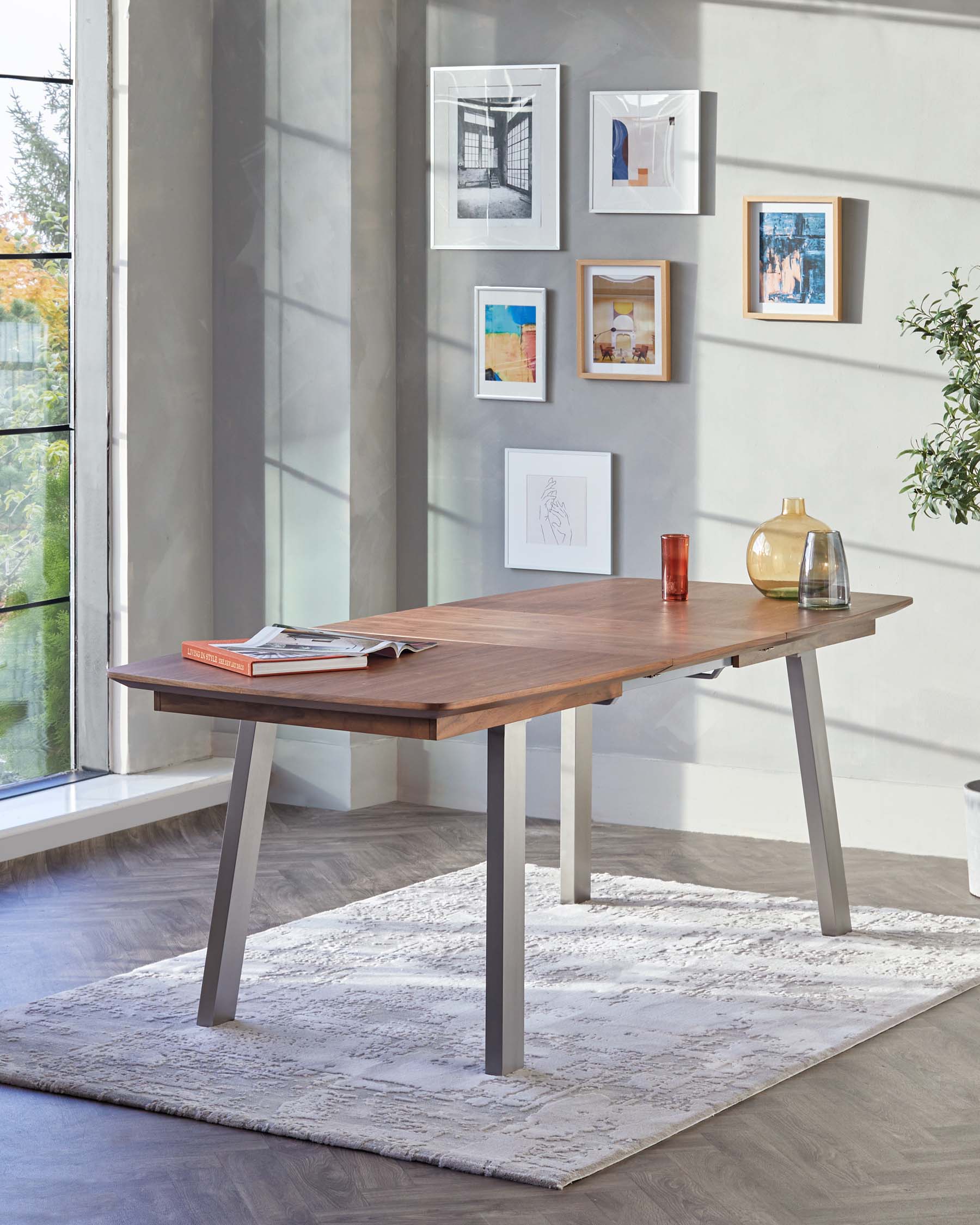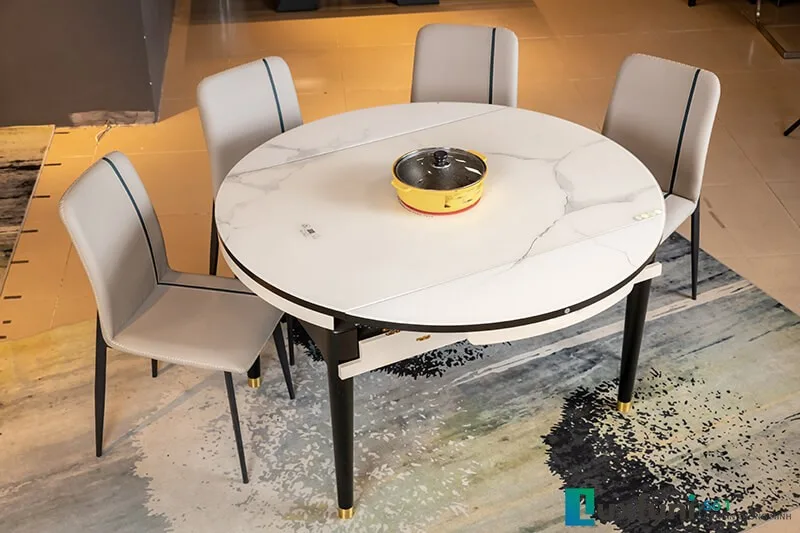News
Introduction to Wooden Dining Tables, Round Tables, and Extendable Tables: Advantages and Disadvantages



The Psychology of Dining Table Colors
Color is more than just visual; it affects the atmosphere of your dining space.
Warm Wood Tones
Shades like walnut, cherry, and mahogany bring warmth and richness. They make dining rooms feel cozy and encourage longer conversations at the table.
Light Neutrals
Pale oak, ash, or white-painted tables create openness. These tones work best in small spaces where brightness is needed to prevent a cramped feeling.
Bold and Modern Colors
Black or deep gray tables provide a contemporary edge. They pair well with minimalist or industrial interiors but require thoughtful lighting to prevent heaviness.
Choosing Tables Based on Room Size
Small Apartments
Round tables shine in compact spaces because they eliminate corners, making the flow of movement easier. Extendable tables also work well, as they expand only when needed.
Medium-Sized Homes
For medium dining areas, wooden rectangular tables balance function and style. Pair them with matching chairs to create a grounded look.
Large Open-Plan Homes
Grand rectangular or oval wooden tables dominate spacious rooms beautifully. Extendable versions allow for flexibility when hosting, while luxurious round tables create intimate dining zones even in large layouts.
Lifestyle Case Studies
The Entertaining Couple
Lina and Mark love hosting dinner parties in their small city apartment. They opted for a round extendable table that comfortably seats four daily but expands to seat eight for gatherings. Its light oak finish blends seamlessly with their Scandinavian décor.
The Family of Five
The Ramirez family needed durability and space. Their solid walnut rectangular table anchors the dining room, providing enough space for homework, meals, and family activities. Its timeless design ensures it will last for decades.
The Solo Professional
James, a young professional, wanted functionality without bulk. He chose a compact extendable glass-and-wood table that serves as both a dining table and work desk. Its clean lines fit into his modern loft.
Balancing Budget and Style
Dining tables are long-term investments, but budget plays an important role.
Affordable Options: MDF or veneer tables provide style at a lower cost, though they lack the longevity of solid wood.
Mid-Range Choices: Solid wood tables in oak or beech balance durability with value. Extendable mechanisms in this range offer practicality.
Luxury Investment: Handcrafted hardwood tables with intricate designs or high-end extendable mechanisms provide unmatched elegance and longevity.
When budgeting, prioritize materials and craftsmanship over trendy finishes. A well-made table can be refinished or adapted to new décor over time.
Common Mistakes to Avoid
Ignoring Room Measurements
One of the most frequent mistakes is choosing a table that overwhelms the space. Always measure the dining area and leave at least 90 cm of clearance around the table for comfortable movement.
Overlooking Seating Needs
Some buyers focus only on aesthetics and forget functionality. A round table may look stunning but might not provide enough seating for large families.
Neglecting Maintenance
Glass tables look modern but require constant cleaning. Wooden tables need polishing and protection from heat or scratches. Understanding upkeep prevents future frustration.
Forgetting Lifestyle Fit
A glossy luxury table might be unsuitable for households with children. Similarly, a small round table won’t serve families who frequently host guests. Always match design with real-life use.
How Dining Tables Define Dining Room Atmosphere
The dining table is not just furniture—it sets the emotional tone. A large rustic wooden table creates warmth and tradition, while a minimalist black table brings sleek modernity. Round tables soften the space, inviting intimacy, while extendable tables reflect flexibility and adaptability.
By choosing wisely, you create not only a functional eating space but also a reflection of your values, lifestyle, and aesthetic preferences.
How Dining Table Shapes Influence Interior Flow
Rectangular Tables
Rectangular dining tables dominate traditional dining rooms because they maximize seating. They align naturally with rectangular spaces and create a formal atmosphere, especially when paired with upholstered chairs and chandeliers.
Round Tables
Round dining tables encourage closeness and softer movement around the room. They minimize sharp edges and are ideal for family homes where young children play freely.
Oval Tables
Oval tables are a hybrid between round and rectangular. They save space compared to long rectangles while offering more seating than small round models. Their flowing edges soften the lines of modern interiors.
Square Tables
Square tables fit compact dining corners beautifully. They bring balance to square-shaped rooms but can feel limiting in long spaces.
Pairing Dining Tables with Chairs and Lighting
Choosing the Right Chairs
The dining table is only half the story. Chairs complete the experience.
Wooden chairs match wooden tables for classic cohesion.
Upholstered chairs add comfort and elevate the atmosphere, especially for rectangular or oval tables.
Modern metal or acrylic chairs pair with glass or extendable tables for a sleek, contemporary look.
Lighting Considerations
Lighting sets the mood over the dining table.
Chandeliers: Elegant above rectangular wooden tables.
Pendant lights: Perfect for round or square tables, centering attention.
Track or recessed lighting: Works well in open-plan layouts, ensuring flexibility.
Ergonomics and Comfort in Dining Table Design
Height Matters
The standard dining table height ranges between 71–76 cm. Too high or too low affects comfort, especially during long meals. Always test the height with chairs before purchasing.
Legroom and Table Supports
Tables with bulky pedestals or thick legs may restrict legroom. Round pedestal tables often solve this issue, allowing freer movement compared to four-legged rectangular models.
Table Surface Space
Each diner needs at least 60 cm of width and 40 cm of depth for comfortable dining. Extendable tables should be checked when expanded to ensure guests still have adequate space.
Cultural Preferences Around the World
European Elegance
In many European countries, heavy wooden rectangular dining tables dominate, symbolizing tradition and family gatherings. Extendable designs are also popular to host large Sunday meals.
Asian Functionality
In Japan and China, round tables are associated with harmony and equality, particularly in restaurants and family celebrations. In smaller homes, compact extendable designs are favored for space-saving efficiency.
Mediterranean Warmth
Southern European homes often feature rustic wooden tables with natural finishes. These pair with terracotta tiles and warm-toned décor, emphasizing hospitality.
North American Modernity
In urban U.S. and Canadian homes, extendable tables with sleek lines are increasingly popular. They match open-plan layouts, accommodating both daily meals and social gatherings.
Future Dining Table Innovations Beyond 2025
Smart Dining Tables
Technology is entering dining spaces. Future models may include wireless charging pads, built-in speakers, and integrated lighting controls.
Sustainable Designs
Eco-friendly materials, like reclaimed wood and recycled metals, will define next-generation dining tables. Consumers are increasingly aware of environmental impact.
Modular Dining Tables
Imagine tables that can shift shapes: a rectangular table transforming into a round one, or modules that expand into multiple surfaces. Modular systems provide unmatched adaptability for evolving lifestyles.
Multi-Functional Tables
Dining tables doubling as workstations or storage units are already in demand. With remote work on the rise, future models will continue blending living and working functions seamlessly.
Why Dining Tables Matter More Than Ever
Today’s homes are shrinking in size yet growing in multifunctional demand. The dining table has become more than a place to eat—it is a workspace, a social hub, and a centerpiece of design. Wooden dining tables embody tradition, round tables encourage connection, and extendable tables deliver flexibility for modern living. By understanding shape, ergonomics, culture, and future trends, homeowners can make informed choices that suit both their practical needs and personal style.
Styling Dining Tables with Décor Accessories
A dining table does not live in isolation. The right accessories highlight its beauty and enhance its role as the centerpiece of the room.
Table Linens and Runners
For wooden dining tables, linen or cotton runners protect the surface while adding texture. Light fabrics soften dark wood, while bold-colored runners accentuate pale finishes.
Centerpieces
Round tables benefit from single central arrangements such as vases of flowers or bowls of fruit. Rectangular tables suit elongated arrangements like candles or greenery running across the length. Extendable tables require flexible, movable décor that adapts when the table expands.
Seasonal Styling
Spring: pastel flowers and light fabrics.
Summer: bright ceramics and tropical plants.
Autumn: rustic pumpkins, earthy tones, and wood accessories.
Winter: metallic accents, candles, and deep hues.
Dining Table Placement and Layout Strategies
In Open-Plan Homes
For large open layouts, placement defines zones. Rectangular wooden tables often anchor the dining area, separating it from living spaces. Round tables can create cozy corners in otherwise vast interiors.
In Small Apartments
Space optimization is key. Extendable tables placed against a wall save floor space when not in use. Round pedestal tables in corners maximize circulation.
In Formal Dining Rooms
Here, symmetry matters. A grand wooden rectangular table with matching chairs and a centered chandelier creates elegance. The layout is balanced and commanding.
Near Natural Light
Placing tables near windows enhances their aesthetic appeal. Wooden finishes glow under natural light, while glass-topped extendable tables sparkle, adding to the airy atmosphere.
Maintenance and Care for Different Materials
Wooden Tables
Clean spills immediately to prevent stains.
Use coasters and mats to avoid scratches.
Polish periodically to preserve shine and longevity.
Glass Tables
Wipe daily to avoid fingerprints.
Avoid heavy impacts that may cause cracks.
Pair with minimal décor to prevent clutter.
Extendable Mechanisms
Keep joints lubricated for smooth sliding.
Avoid excessive weight when extended.
Clean hidden crevices regularly to prevent dust buildup.
Proper care ensures that dining tables remain not only functional but also visually appealing for years.
Dining Tables for Different Lifestyles
Families with Children
Durable wooden tables with rounded edges are ideal. They withstand daily wear, art projects, and family meals. Extendable models allow flexibility for guests.
Couples in Apartments
Round or small extendable tables offer intimacy without overwhelming compact spaces. Sleek modern finishes keep interiors light and stylish.
Single Professionals
A multifunctional extendable table can double as a work desk. Minimalist designs in neutral tones suit lofts or studio apartments.
Frequent Entertainers
Large extendable or oval tables suit those who host dinner parties. Pairing them with upholstered chairs and statement lighting elevates the dining experience.
Design Inspirations from Real-World Trends
Scandinavian Simplicity
Scandinavian interiors favor light oak tables, paired with neutral chairs and natural fabrics. Round extendable tables are common for compact Nordic apartments.
Rustic Farmhouse
Farmhouse dining rooms feature large wooden rectangular tables, often reclaimed, paired with mismatched chairs and rustic décor. This creates a welcoming, casual vibe.
Modern Minimalism
In urban settings, sleek black or glass extendable tables dominate. Paired with monochrome chairs, they reflect clean lines and contemporary style.
Eclectic Bohemian
Bohemian homes often feature round wooden tables surrounded by colorful, upholstered chairs. Décor includes vibrant runners, plants, and artistic accessories.
Why Dining Tables Reflect Personal Identity
Every dining table tells a story. Wooden tables often symbolize tradition and permanence, round tables emphasize connection and inclusivity, and extendable tables represent adaptability and modern practicality. By styling them thoughtfully, placing them strategically, and maintaining them well, homeowners can ensure their tables remain central to both function and design.
Dining Tables and Social Dynamics
A dining table is more than furniture—it influences how people interact.
Round Tables for Equality
Round tables eliminate hierarchy since everyone is seated at equal distance. In family settings, this encourages open dialogue. In business or social dinners, it reduces formality and makes conversation more fluid.
Rectangular Tables for Formality
Rectangular wooden tables often establish structure. The person at the “head” naturally assumes authority, making them common in traditional family gatherings or formal dining experiences.
Extendable Tables for Flexibility
Extendable tables represent adaptability. They accommodate both intimate dinners and festive occasions. Socially, they promote inclusiveness—nobody feels excluded when extra guests arrive.
Dining Tables as Multifunctional Hubs
Modern lifestyles have transformed dining tables into multipurpose surfaces.
Work and Study
Remote work and online learning mean dining tables often double as desks. Extendable models are particularly useful, as one section can remain for meals while another serves as a workstation.
Creative Activities
Families use wooden tables for crafts, board games, or baking projects. The sturdiness of wood supports diverse activities. Round tables, with no corners, make shared activities easier and more interactive.
Social Gatherings
Birthday parties, holiday dinners, and casual hangouts often center around dining tables. Extendable designs shine here, adapting to fit more people without requiring additional furniture.
Material Innovations Beyond Wood
While wood dominates, alternative materials are gaining traction.
Glass
Glass tables exude modern elegance and reflect light, making rooms feel larger. They pair well with minimalist interiors but require frequent cleaning.
Metal
Metal tables, often with steel or aluminum bases, suit industrial or contemporary homes. They are durable but may feel cold if not balanced with warm décor.
Stone and Marble
Marble dining tables symbolize luxury. Their veined surfaces create unique artistry, though they are heavy and require sealing to prevent staining.
Mixed Materials
Combinations like wood-and-metal or glass-and-wood tables provide visual interest. Extendable tables especially benefit from hybrid designs, merging functionality with style.
Environmental and Sustainability Factors
Eco-conscious buyers are increasingly considering sustainability.
Reclaimed Wood
Tables made from reclaimed wood reduce waste while offering unique character. Each piece carries history, adding depth to home interiors.
Bamboo and Fast-Growth Woods
Bamboo grows quickly, making it an eco-friendly alternative. It creates lightweight yet durable tables suitable for modern spaces.
Low-VOC Finishes
Non-toxic finishes protect both the furniture and household health. Families with children often prefer tables with eco-friendly coatings.
Longevity vs. Disposal
Solid wooden tables last decades, reducing replacement waste. In contrast, cheaper particleboard tables may end up in landfills quickly. Investing in quality supports both durability and environmental responsibility.
Real-Life Examples in Different Homes
The Cozy Apartment
Ana lives in a compact studio. She chose a small round wooden table with a light oak finish. It doubles as her work desk and dining spot. Its neutral tone complements her white walls and laminated floors.
The Family House
The Tran family uses a large extendable walnut table in their suburban home. On weekdays, it seats five comfortably. On weekends, it expands to fit extended family for dinner. The warm walnut tone creates a welcoming atmosphere.
The Modern Loft
Chris owns a downtown loft with an industrial vibe. His glass-and-metal rectangular table matches concrete floors and exposed brick walls. While minimal in design, it becomes a centerpiece when styled with pendant lighting.
The Luxury Villa
In a Mediterranean villa, a marble oval dining table dominates the open-plan dining room. Surrounded by upholstered chairs, it exudes sophistication and reflects the homeowners’ love for grand entertaining.
Dining Tables as Emotional Anchors
Beyond practicality, dining tables carry memories. They witness birthdays, family discussions, festive feasts, and everyday meals. Choosing a table thoughtfully ensures it becomes more than décor—it becomes a part of family history. Wooden dining tables symbolize tradition, round tables embody connection, and extendable tables capture adaptability. Each tells a different story but shares one truth: the dining table is where life happens.

